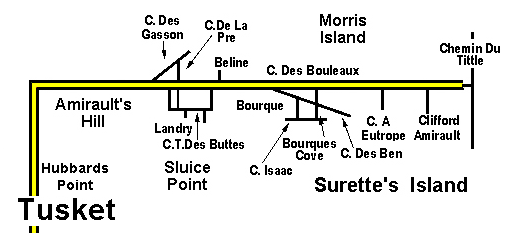 |
Research by: G.J.LeBlanc (GrassRoutes) Click on pictures for source or enlargement of picture |
 |
Research by: G.J.LeBlanc (GrassRoutes) Click on pictures for source or enlargement of picture |
 During
the Golden Age (1713-1748) the Acadians had cultivated a remarkable sense
of independence with respect to their neighbors. They remained proud of
the French language, their Roman Catholic faith, their families and communities,
as well as their culture and work. Many of these elements are still valued
today. During
the Golden Age (1713-1748) the Acadians had cultivated a remarkable sense
of independence with respect to their neighbors. They remained proud of
the French language, their Roman Catholic faith, their families and communities,
as well as their culture and work. Many of these elements are still valued
today.
The strong Catholic Faith of the Acadians is said to be the glue that
kept these oppressed people together even after their expulsion from their
lands in Nova Scotia to the USA, England, France and other parts of Canada
during the years 1755 to 1763. Some probably did remain hidden in wooded
areas but survival would have been rough. In 1763 according to the
Treaty of Paris France lost all its territories in North America
except the Islands of Saint-Pierre and Miquelon and the Louisiana territory. In 1766 Ranald MacKinnon (The MacKinnons of Argyle)a british officer was granted 2000 acres of land in the argyle area. he leased the land to Acadians in the area who cleared and developed the it. Over 230 acres were eventually purchased by Acadians who settled the area. Most of the settlers of Surette's Island came from the parish of Saint Anne du Ruisseau (Eel Brook) which was formed by father Sigogne around 1799. (Brief Story of Sainte-Anne-du-Ruisseau) This was part of the territory of Cape Sable which we now refer to as Sheburne and Yarmouth Counties. Saint Anne du Ruisseau was established about 20 years previous by a small group of Acadians who managed to escape deportation by the British. One of these individuals was Pierre Surette. Pierre II was born in Port-Royal in1709. Pierre II Surette had married in Grand-Pre, September 30th, 1732(s). After the Treaty of Paris in 1763 he was released from a prison in Halifax, about 6 or 7 later he moved to SAR(s).
|
| Surette's Island (Some information
here is based on a book by Neil Boucher " The Development of an Acadia
Village")
On November 28 1855 the first mass was celebrated on Surette's Island in the home of Frederic Surette by Father J.P. Rolls of SAR parish. This small chapel was constructed in 1934 to commemorate the location of this first mass. The early inhabitants did not have their own church so they would have to row to SAR to attend church. By 1859 a mission church was constructed. It was named "Our Lady of the Islands" and was a mission parish of SAR. The population of Surette's island and Morris Island at this time was estimated to be about 300. The Catholic priest were one of the main factors influencing these early Acadian communities. The priest was usually the best educated member of the community and he often presided over disputes and legal documentation. Parishioners were encouraged to stay in the community, settle in the surrounding lands and develop them, rather than moving to other areas. This policy was probably developed by one of the more influential priests of the area Fr. Sigogne. He also took the first steps toward educating the Acadians of the area. He assisted in bringing in the first teachers and the first members of the legislative assembly. After the Tupper's public school act of 1864 the province took up the role of education, however the parish priest still held the position of implementing educational policy in the rural areas. |
 The pre-expulsion Acadians lived in areas that had fertile land that yielded abundant crops. When some returned from exile the land they were granted was usually rocky and near the coast so many turned to the sea as a source of income. The sea proved to be very profitable for the Acadians. However, after 1870 the industry declined. Between the 1st and 2nd world wars many people left for the Boston area. Three hundred and fifty from the Wedgeport area alone. Morris Island was almost diserted. Since many fisherman spent most of their time supplying the New England market, their famlies moved there. Though Surette's Isand was isolated in the 1900's they remained in contact
with activities in other Acadian areas via papers such as Le
Petit Courrier, (http://lecourrier.com/),
L'Evangeline
and La
Societe L'Assomption. These publications tried to preserve the
Acadian culture.

Links to some Surette's
who have signed our guest book Although we do our best to be accurate, all researchers should consider verifying and researching their own personal information from primary and secondary sources. This is recommended because standard genealogical research practice is to always seek data from more than one source, and to be confident about your own research, it is a good idea to conduct further research via genealogy books, parish registers, census records (and their correct interpretation), vitals, etc. |
| Links | ||
| Virtual Museum | Pictures from Shelburne County Museum Shelburne , Nova Scotia | |
| SURETTE'S ISLAND MEMORIAL | Memorial is in front of the church, Notre Dame des Iles, on Surette's Island | |
| Acadian & French Canadian Ancestral Home | Excellent site with probably all the links you will need to Acadian information |
Information can be added the villages pages by contacting
webmaster@yarmouth.org